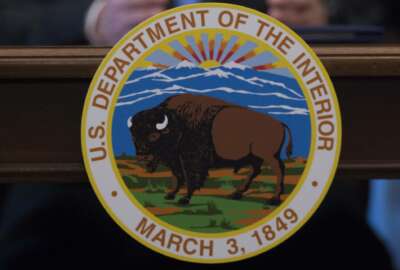
Exclusive
Interior no. 2 details his intention and rationale for reassigning more senior executives
In a memo, Interior Deputy Secretary David Bernhardt outlined his vision for the SES and his preference for the future to reassign and rotate more career leaders.
More than six months after the Interior Department reassigned 30-to-50 of its senior executives, the agency’s deputy secretary is offering more insight into the role he foresees for DOI’s most experienced career leaders.
In a Dec. 4 memo to all Interior senior executives, Deputy Secretary David Bernhardt detailed his vision for the agency’s Senior Executive Service members.
“As I have examined our processes, consulted with the Office of Personnel Management and requested that the secretary reconstitute the membership of the [Executive Resources Board] to adopt best practices, I thought it would useful to share my understanding of the role the Senior Executive Service plays in leading the department,” he wrote.
Though the memo, which Federal News Radio obtained, didn’t explicitly announce plans to reassign more senior executives, it’s clear Bernhardt sees these rotations as a potentially valuable management tool.
“It is my view that potentially greater cross-bureau collaboration and innovation can be achieved by bringing new leadership perspectives to our operations by rotating SES members from bureaus to headquarters, from headquarters to the field and across different functional areas and disciplines,” Bernhardt wrote. “Going forward, I will seek to strike a balance between leadership continuity and achieving fresh perspective by reassigning SES employees across bureaus and offices.”
Interior senior executives who were moved to new positions in June said the reassignments created a “chilling effect” in the department, and they said they feared how the agency’s reorganization effort would impact the workforce when the department’s executive cadre has had “absolutely no involvement whatsoever” in crafting the agency’s plans.
Bernhardt’s latest memo shows Interior is trying to be more proactive and communicative with its career senior executives, said Bill Valdez, president of the Senior Executives Association.
Though it may have been wise for Interior to send such a message to its SES members six months ago, having leadership alert the agency’s senior executives about its intentions is a good management practice, he said.
“This letter is perhaps an indication that they’re taking a step back and being more thoughtful about what they’re doing,” Valdez said.
Bernhardt’s memo also reminds senior executives of the principles that guide the SES under the Civil Service Reform Act of 1978. Those principles, Bernhardt said, will inform his decisions as chair of the department’s Executive Resources Board.
Each agency typically appoints members to serve on an Executive Resources Board (ERB), which reviews qualifications for new career applications to the SES. According to OPM, these boards also advise agency heads on executive human resource management. These boards usually dissolve during a change in administration and staff back up when new leadership arrives.
Bernhardt also reminded executives of former President Barack Obama’s 2015 executive order, which directed agencies with more than 20 or more SES positions to rotate at least 15 percent of its members to different departments, agencies, subcomponents, functional areas or even sectors.
According to Bernhardt, Interior senior executives during the Obama administration completed 140 SES reassignments within the department. Of the executives who did rotate to other positions, few moved to different bureaus in the department, he added.
Latest SES News
“From my perspective, the lack of mobility can contribute to a siloed, bureau-centric approach to management,” Bernhardt wrote. “Although a long length of service in one position can be a management strength, as it allows for the development of technical expertise and continuity, it can also inhibit the transfer of fresh management concepts across bureaus and offices.”
Bernhardt said he also plans to focus more on strengthening executive accountability. About 98 percent of Interior SES members received an “outstanding” or “exceeds fully successful” rating on their performance evaluation for 2016, the memo said.
“Each of you should be proud of your membership in the SES and your accomplishments as executives,” Bernhardt wrote. “I look forward to working with each of you. Thank you for your service.”
Bernhardt’s memo comes as the department’s Office of Inspector General is continuing its review of the methodology and the criteria agency leaders used to reassign SES members.
According to an email to Interior senior executives, which Federal News Radio obtained, the IG said it was meeting with impacted SES and others involved in the reassignment process. The IG also encouraged senior executives who haven’t come forward to contact the inspector general or its anonymous hotline by Nov. 10.
Meanwhile, former Interior senior executive Joel Clement, who said he was reassigned in retaliation for his statements about climate change, has filed a lawsuit against the department. Interior had yet to comply with any of Clement’s more than 30 Freedom of Information Act (FOIA) requests related to the agency’s decision to reassign some of its career executives.
Clement resigned in October, citing poor leadership as one of the reasons for his departure.
Copyright © 2024 Federal News Network. All rights reserved. This website is not intended for users located within the European Economic Area.
Nicole Ogrysko is a reporter for Federal News Network focusing on the federal workforce and federal pay and benefits.
Follow @nogryskoWFED





